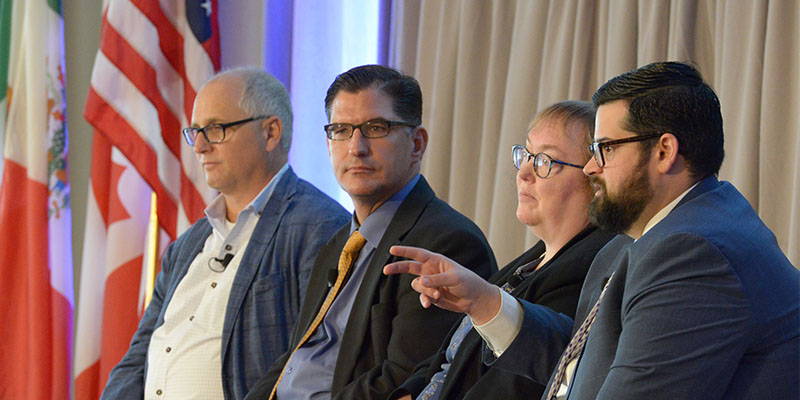At I.CON East 2019, panelists discussed new initiatives and strategies for addressing the industrial workforce shortage that many of their tenants face. Mark Shearer, senior vice president, regional development officer, Rockefeller Group moderated the panel with Steven Hussain, director, community workforce programs, Prologis; Patrick Robinson, vice president of development, NorthPoint Development; and Anne Strauss-Wieder, director, freight planning, North Jersey Transportation Planning Authority.
The topic – certainly one that came up throughout many sessions at I.CON – has presented a significant challenge to industrial tenants trying to recruit and retain workers to keep up with e-commerce demand and trends in second-day, next-day or even same-day delivery.
Robinson shared an anecdote about a project he had many years ago where job seekers were actually driving to the job site inquiring about job openings. He partnered with a local workforce development agency to set up a clearinghouse for resumes. In the local area they found that around 1,500 high school students per year didn’t go on to college, and the project was creating jobs at a rate of about 1,000 jobs per year. “Sacrificing 500 square feet for a learning center and classroom to facilitate training was certainly doable for the project,” he said.
“I feel like our job is to walk in the shoes of our tenants, and labor is very important to them right now,” Robinson added. “The dynamic is different today; you have to get upstream and downstream to be effective.”
“We’re trying to think about labor solutions in the different markets where we serve our customers,” said Hussain. “We’ve piloted several programs over the past 18 months, working with community colleges and local schools, and we hope to scale them.”
Strauss-Wieder pointed out that a typical fulfillment center requires up to three times the employment volume of a typical warehouse. “Think about how many workers that means, about what’s required to market to these employees, and accessibility – how the employees are getting to your building.”
“Transit agencies are used to serving office buildings or malls,” said Strauss-Wieder. “This is a relatively new phenomenon that we now have tremendous amounts of workers traveling to warehouse facilities.”
Strauss-Wieder shared an example from Robinsville, New Jersey, where Amazon worked with a local transit authority to create a shuttle service from a major service station to transport workers directly to their buildings.
“Our tenants are changing their shift times so they match up with the bus schedules,” added Robinson.
Strauss-Wieder also mentioned that in Europe, integrated logistics centers exist that include not only the industrial building, but a daycare, a place to get food, and other services. “Those buildings can serve as a buffer between industrial buildings and residential buildings,” she pointed out, “And not only do those buildings serve employees, they serve the communities.”
The truck driver shortage was also a hot topic among the panelists.
“Why should you care about the driver shortage?” said Strauss-Wieder. “Because that’s the second thing your occupier is thinking about: ‘Am I going to get the truck service I need for my building?’”
The American Trucking Association reports that 60,000+ jobs need to be filled in truck driving. To better appeal to potential employees and retain their existing employees, companies are developing new amenities. What was previously a “cage” where a truck driver would sit and complete paperwork at a site before heading back out on the road has become more of a lounge, where drivers can relax, heat up food, watch TV and surf the web while their truck is restocked.
“We’ve even put in a dog park in one of our parks,” said Robinson. “We’ve seen the volume – it’s getting used by the truck drivers even more than we thought.”
“Sometimes the best thing to do is go over and interview the workers about what they want,” said Hussain. “It might just be good coffee, or a vending machine close by. Air conditioning, fans, etc. are a small cost to retain workers when a company is experiencing 150% turnover for a warehouse that has 1,000 employees.”
“There’s really no substitute for talking to the workers themselves,” agreed Robinson. “Not the managers, but the forklift drivers. You need to understand if their job is, for example, a secondary income where benefits are not as important, or – as is common in a more rural area – it’s the primary income and benefits are more important to them.”
Strauss-Wieder brought up another amenity that is often overlooked: a “ladder for growth,” or, in other words, a path to promotion, a clear understanding from the employee about how they can build new skills and train on new technologies as they are introduced.
“There’s been this fear that automation is taking away jobs, but were really not seeing that,” sad Hussain. “We’re just seeing the jobs change – and the current system is not built to adapt to the change. So it’s important to find ways to address this challenge.”
All panelists agreed that for change to occur, everyone in the room at I.CON East would need to do their part to help address the workforce shortage.
“Partnerships are a recurring theme throughout NAIOP, but they’re particularly necessary here to help address the workforce issue,” said Strauss-Wieder. “We need to work with the community, other companies, and transportation organizations.”
“The broader system of education and training isn’t working for your customers or the logistics industry at large,” said Hussain. “And as the industry becomes more sophisticated, the issue will become more acute.”
“I’d encourage everyone who hasn’t paid enough attention to this topic to start paying attention,” said Robinson. “Your unique strategy to approaching the problem might be what sets you apart in securing a new tenant. I think this is a call to action for everyone.”
“The more organizations that rally around the need for talent, the easier it gets for all of us,” said Hussain. “We hope people will see our solutions and try to replicate them.”
The NAIOP Research Foundation has published a report on this topic titled “Addressing the Workforce Skills Gap in Construction and CRE-related Trades.”
This post is brought to you by JLL, the Social Media and Conference Blog sponsor of NAIOP’s I.CON East: The Industrial Conference. Learn more about JLL at www.us.jll.com or www.jll.ca.















